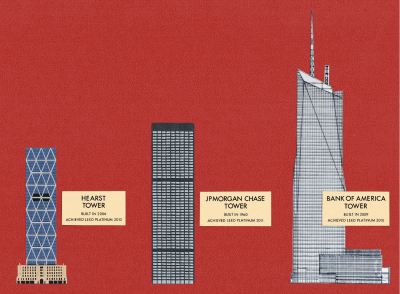Transparently Green: Landlords, Tenants, Gear Up for Local Law 84
By Daniel Geiger March 12, 2012 7:00 am
reprintsIn the spring, the Mayor’s Office of Long-Term Planning and Sustainability will release data for the first time revealing energy consumption in office buildings in the city.
By making such figures available to the public, Mr. Bloomberg hopes to essentially do to building owners what he has done with national food chains: incentivize them—or shame them, depending on your perspective—into significantly reducing their energy consumption.
“A customer will go into a restaurant now and they’ll say to themselves, ‘maybe I won’t have that doughnut that has 500 calories’,” said Constantine Kontokosta, a professor at New York University and director of its Center for The Sustainable Built Environment, a working group that is assisting the city with its analysis and release of the electrical consumption data.
“On the producer side, you have companies like Starbucks who are also responding to the disclosure, rearranging their offerings so they no longer have 1,000 calorie cupcakes but healthier fare.”

Making the electricity data public will do the same thing for Manhattan’s roughly 400 million square feet of office buildings. Making the numbers transparent will encourage a degree of healthy competition between landlords over whose building is most efficient. “They’re going to want to make sure their buildings can compete with their peers,” Mr. Kontokosta said.
There is little doubt that Mr. Kontokosta is correct. Commercial leasing brokers widely say that tenants in the city value properties that have LEED certification, a benchmark given to buildings that meet a host of criteria for efficiency and sustainability. Those same benchmarks, meanwhile, often result in a host of other benefits for tenants, like lower rates of absenteeism and sick days at work. “It’s better for them economically, since the bulk of their costs are on personnel,” he added.
The rub in all of this, however, is that landlords believe that while the data will reflect on their building’s energy consumption, it’s the tenants–not the owners–burning all that power.
“There’s concern that there is going to be the focus flat out on energy consumption and it’s not going to reflect how efficient a building really is,” said Steve Spinola, president of the Real Estate Board of New York.
Mr. Spinola was referring to office towers like One Bryant Park, a soaring 2.1-million-square-foot skyscraper developed in recent years by the Durst Organization. The building is widely regarded as one of the city’s most sophisticated office properties, with cutting edge environmental efficiency features that allowed it to earn LEED’s highest efficiency rating.


